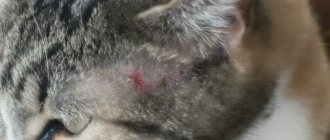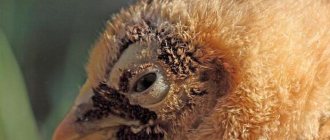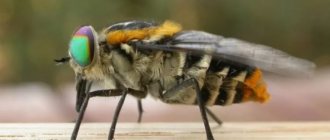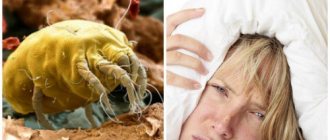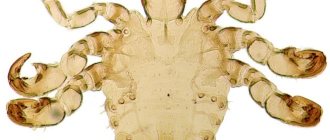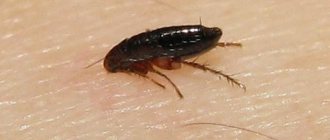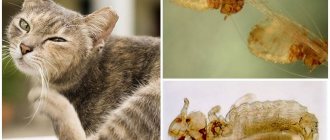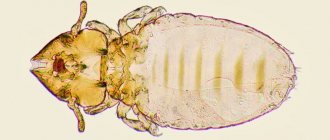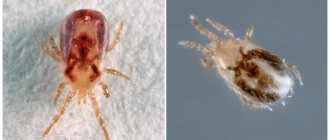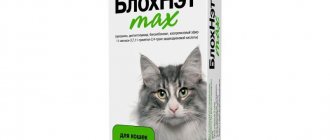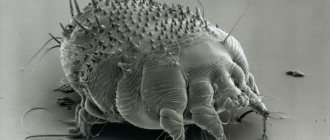Symptoms of animal infection, how to identify the parasite from a photo, why lice eaters are dangerous for cats and humans. How to treat, including traditional methods.
Cat owners take flea and tick prevention. However, they forget that lice eaters, which are no less dangerous, can also live on the body of their pets.
In this article, you will learn how to identify a lice beetle infestation and how to treat your animal without harming it.
Cat lice eaters are flightless insects about 2 millimeters in size. They have a large head, an oblong abdomen, a powerful biting apparatus, and three pairs of legs with which they cling to fur. They are yellowish in color and live on the bodies of warm-blooded animals, including cats.
The food for lice eaters are tiny particles of skin and fur, as well as dried blood.
The eggs of lice eaters are almost impossible to comb out or wash, since they are attached with a special sticky secretion, and therefore getting rid of nits is not easy.
Lice eaters are not transmitted to humans , but it is unpleasant to understand that some insects live in the house, and even more so on the body of your beloved purr, which can cause serious harm to his health.
What do lice eaters look like in cats?
Lice eaters (appearance)
Photo of a lice eater under a microscope
Scratching when affected by lice eaters
What lice eaters look like on fur
How to avoid infection?
Prevention measures include, first of all, protecting your pet from contact with street animals that may be infected with lice eaters. In addition, it is worth:
- carry out disinfection regularly
- thoroughly clean the dog’s habitat;
- regularly wash bedding and beds;
- at least twice a week;
- use a parasite collar;
- Go to the veterinarian regularly for preventive examinations.
In conclusion, we can add that the sooner treatment is started, the less harm the dog will have to suffer from ticks. And of course, the lower the risk that lice eaters will spread to people.
Additionally, watch a short video on how to treat your pet's fur from lice and other parasites:
Ways to infect cats with lice eaters
- Upon contact with a sick animal.
- From mother to kittens.
- When catching rats or mice infected with lice eaters.
- Through grooming items.
The latter method of infection is not very common, since this type of ectoparasite is drawn to warmth and will rarely linger on cool tools.
Not a single cat is immune from lice-eater infection. At risk are animals with weakened immune systems (sick, after surgery, kittens, elderly), as well as those who receive an unbalanced diet or live in uncomfortable conditions.
Lice eaters can appear in cats at any time of the year.
Signs of infection
The main symptom by which the presence of parasites can be determined is severe itching. It is worth mentioning other signs of infection.
- “Feeding” from the cat’s skin wounds, lice eaters leave their saliva there. By becoming sensitized, it provokes an allergic reaction in the animal. A skin rash can be found in these areas. An infection is connected to it, and pustules form on the body.
In places of calculations, the dermis thickens, coarsens, and becomes rough. The skin swells, and pockets of inflammation remain on it for a long time.- By eating cat hairs, the parasite spoils the animal's coat. As a result, large bald spots can be found on many parts of the body.
- A characteristic sign of the presence of a lice eater is bristles gathered into sticky clumps. Cats with long hair are especially affected by this.
The animal on which lice eaters live becomes weaker and its immunity drops. This leads to an invasion of subcutaneous mites. Otodectosis, notoedrosis, and demodicosis develop.
To finally make sure that a cat has lice, you should carefully examine its feces. There will definitely be remains of cucumber tapeworm there.
Symptoms of cat infestation with lice eaters
Lice eaters have settled on your cat's body if:
- she constantly itches, licks the fur with her tongue, tries to gnaw out an insect with her teeth;
- scratches and small blood spots, rashes, scratching, eczema, dermatitis appeared on the pet’s skin;
- bald spots appear due to hair loss;
- the cat behaves restlessly, stops obeying the owner, gets nervous for no apparent reason, ignores toys;
- sleep patterns are disrupted due to constant itching.
How can you easily distinguish lice eaters from ticks and fleas?
To do this, just hold the animal near a heat source (for example, near an incandescent lamp or an open window through which the sun shines) for several minutes. Fleas and ticks will not react to this in any way, but lice eaters will begin to actively crawl out of the depths of the fur closer to the heat source.
If your cat does have fleas, then read how to deal with them.
Who are the lice eaters?
There are real legends around lice-eating parasites: they supposedly dig “tunnels” in the skin of animals and can eat all the hair. Also, many owners mistakenly consider lice eaters to be ticks. But in fact, lice eaters have nothing to do with mites and look more like lice. Lice eaters are insects that belong to the order of lice and lice. Over 200 species of lice eaters have been described, and about 120 species of these parasites are found in Russia.
Features of lice eaters
The distinctive features of lice eaters are as follows:
- size about 1–2 mm;
Lice eaters do not exceed 2 mm in length
- lack of wings;
- the abdomen is long, oval and divided into 9 segments, covered with small sparse setae;
- there is a short, poorly developed chest of three segments, on each segment two pairs of legs grow, each ending with a sharp hook with which the lice eater clings to the skin;
- the head is very large (wider than the chest), with short antennae, mouth and underdeveloped eyes, square or triangular in shape;
- The color of the insect is light brown, yellowish or whitish.
Lice eaters feed on:
- dead particles of the epidermis;
- blood that seeps from scratching;
- microparticles of wool.
Cat lice worms are not transmitted to humans.
Lice eaters reproduce very quickly. At one time, the female can lay up to hundreds of eggs, which she attaches to the animal’s fur using sticky mucus. They hatch into larvae that are very similar in appearance to the imago (the adult stage of individual development of insects). They grow for about a month, going through three stages of growth and molting three times. Lice eaters reproduce most actively in the cold season. Lice eaters, unlike fleas and ticks, cannot survive outside the body of a host animal.
Lice eaters reproduce quite quickly
Lice eaters can be very dangerous for cats for the following reasons:
- can infect a cat with trichodectosis, a skin disease in which the cat loses a lot of hair and develops scratches;
- are carriers of helminths;
- in some cases cause severe allergies and infections;
By scratching the skin from unbearable itching, a cat can introduce a dangerous infection into the wound.
- can bring the cat to severe exhaustion;
- If cats have chronic diseases, infection with lice eaters can cause their exacerbation.
How to treat a cat for lice
All drugs for the treatment of ectoparasites are very toxic and can harm the health of your pet.
If affected by lice eaters, it is recommended to show the cat to a veterinarian. He will make a diagnosis, select adequate treatment, establish a safe dosage of drugs and talk about caring for the animal during treatment, as well as preventive measures. If antiparasitic drugs are used incorrectly, the cat can become seriously poisoned. To prevent this, after treatment with a gel or emulsion, it is better to put a collar on the animal that prevents the drug from being licked from the body.
Your cat should be treated for lice at least twice. The first time, the drug may not have an effect on insect eggs, but will cause the death of adults and newly hatched larvae. After 10-14 days, when repeated treatment, teenage lice-eaters who have not yet had time to produce offspring will also die.
Veterinary remedies for lice in guinea pigs
Note that all remedies for lice in guinea pigs are initially intended to combat ectoparasites in cats and dogs. They are also successfully used to treat mumps, but they must be used carefully. If you apply medications too generously, you can poison your pet.
Sprays
The following sprays can be used:
- "Blokhnet."
- "Dana."
- "Leopard".
- "Inspector".
Apply them to the entire body of the animal, evenly treating the fur. Until the product has completely dried (about half an hour), it is better to let the animal run around the room.
Suspensions
To relieve itching and other unpleasant sensations, the following suspensions can be used:
- “Stop the itch.” In addition to relieving itching, the drug helps accelerate the regeneration of skin damaged by parasites.
- ATOP 7 + in the form of a suspension. Prevents the development of allergies.
Let us warn you once again that these products are not used to destroy parasites, but to alleviate the condition of the pet itself and speed up the process of its treatment.
Attention! All these drugs are not initially intended for pigs, and therefore you should definitely consult a veterinarian before using them.
Shampoos
Numerous antiparasitic shampoos can be used to treat mumps:
- Phytoelite.
- "Dana."
- Frontline.
- "Leopard".
In this case, the animal should be washed with shampoo in warm water, the fur should be rinsed thoroughly and dried with a towel. It must be remembered that in case of severe infestation, shampoo is ineffective; more powerful products should be used. But it is a wonderful addition to sprays, drops and other insecticidal preparations.
Drops on the withers
One of the most effective forms of drugs against lice eaters and other ectoparasites are drops on the withers:
- Frontline. One of the most effective and safe drugs. If possible, it is better to use these drops. They create protection for almost two months and have the lowest possible toxicity.
- Rolf Club. A very effective and powerful product that is guaranteed to destroy the population of lice in just one application. But you need to use it carefully to avoid poisoning your pet.
- "Gamma". A unique preparation based on plant extracts and essential oils. Ideal for pigs as it has almost zero toxicity.
- Baephar. A foreign analogue of Gamma, also produced on a plant basis.
Can it be treated at home?
If the lice-eater infestation has occurred recently and the damage is minor, you can try to treat the animal at home. To do this, you should purchase drugs against ectoparasites (fleas, ticks, lice):
- pet shampoos (“Demos-Lux”, “Flea&Tick Cat Shampoo”, “Bolfo”, “Shampoo B”, “Rolf Club”, “Mr. Kiss”, “Bars”, “Clandestine”, etc.);
- drops (“Bars”, “Clandestine”, “Biafar”, “Frontline”, “Barrier”, “Hartz”, “Advantage”);
- aerosols and sprays (“Bolfo”, “Acaromectin”, “Flea & Tick – 14 Residial Spray”, “Delix-spray”, “Serco”, “Frontline”, “KiSka”).
These medications should be used with extreme caution if lice eaters are found in a kitten.
For small animals with weak immunity, you should use a lower dosage, which your veterinarian will help you choose.
Folk remedies used by animal lovers at home are not as effective as specialized drugs. However, they may well be used in the early stages of infection. For example, an animal can be bathed in a strong decoction of chamomile, string or wormwood.
Treatment
If you find a lice eater in your pet, you should immediately seek help from a doctor. The veterinarian will take a skin scraping, determine the degree of infestation by the parasite, and prescribe appropriate insecticide treatment.
All pets living in the apartment must be treated for the parasite, despite the fact that only one was found to have the lice eater. There is a high probability of larvae getting on the fur of other cats.
Sprays for lice
Using such products is an easy way to combat lice.
How to treat a cat against lice with a spray:
- place the animal in front of you, holding it tightly;
- spray the entire body with an aerosol, except the muzzle, paying attention to the stomach, groin areas, and neck;
- put on a special collar;
- after 2 hours, wash the cat with zoo shampoo;
- repeat treatment after 10 days.
The spray is not used for pregnant and lactating cats, kittens under 3 months.
Effective sprays against lice: Greenfort , Bayer , Rosagroservice .
Drops from lice
Drops against lice will help get rid of the problem, protecting against the invasion of the parasite for a whole month. The drug is applied in places that the cat cannot reach and lick: on the withers, behind the ears, along the spine.
The product is used every 30 days. It is important to apply the number of drops recommended in the instructions, taking into account the weight and age of the cat. An overdose of the drug is fraught with acute poisoning of the animal.
Drops “Bars” , “Advantage” , “Stronghold” .
Shampoos for lice
Anti-ectoparasite shampoo is a safe repellent for cats. It moisturizes the skin, reduces itching, and disinfects wounds. The shampoo is ineffective without the use of an antiparasitic collar. This remedy works well as a preventive measure.
Using anti-hairworm shampoo for cats:
- wet the cat's fur;
- apply shampoo with massage movements to all areas of the body;
- leave the foam for five to seven minutes;
- Rinse thoroughly with warm water.
After bathing the cat, be sure to disinfect the bath or pour boiling water over it.
The advantage of the shampoo is that, together with the collar, it can be used for pregnant females and kittens. However, it is worth remembering that hair mites in cats are not completely washed out with shampoo.
Acaricidal shampoos: Ms Kiss , Rolf Club , BioVax , BIO-GROOM , Celandine .
Emulsions against lice
Emulsion insecticides are diluted with water (5-10 liters of liquid depending on the preparation) and rubbed into the skin of the animal along the spine. The procedure is repeated after 14 days, and then the cat is washed with zoo shampoo. It is important to follow the instructions on the package and correctly calculate the dose of the drug.
For short-haired cat breeds, it is enough to spray with an aqueous emulsion solution, avoiding fine splashes getting into the eyes, nose, and mouth of the animal. It is more effective to treat long-haired pets with a diluted Delcid , blotting the skin with a cotton pad soaked in the emulsion solution, spreading the fur using a single-row comb.
Deltsid is diluted at the rate of 1 ampoule (2 ml) of the drug per 1.6 liters of water. For medicinal purposes, double treatment is carried out with an interval of 10 days. It is recommended to spray the same emulsion in a room where animals are often present. After two hours, ventilate the room, wash the floors and wipe the surfaces using detergents. Spray the room in the absence of pets and children.
The emulsions used are Deltsid , Merial , Agrovetzaschita , Pfizer , and Bionix .
Folk remedies for lice
The initial form of liceworm infection in cats is treated with folk recipes:
- Brew 3 tablespoons of string in 0.5 liters of boiling water. Let it brew for several hours. Cool, strain, rub into the cat’s skin after bathing.
- Boil 3 teaspoons of chamomile flowers in 200 ml of water. Strain through cheesecloth. Pour into a bathtub at the rate of 5 liters of water per glass of broth. Bathe the cat in the solution.
- A tablespoon of dry celandine (2 tablespoons of fresh) is poured into a glass of cold water. Boil the mixture over low heat. Leave the decoction for an hour. Dilute in 5 liters of bathing water.
An important point: the pet must be bathed in these decoctions every day until the lice eaters are eliminated and the scratching disappears. It is worth closely monitoring whether there will be an allergic reaction to medicinal herbs.
Are lice eaters dangerous for humans?
- The animal's temperature is much higher than that of humans , so lice eaters cannot parasitize humans. Insects love warmth.
- The only danger is an accidental parasite bite. Since lice eaters are carriers of infections, humans, like animals, are in danger.
- Worm eggs can be transferred by insects to the human body.
When a dog bites, larvae can enter the bloodstream and develop under the skin. At this moment, itching will be felt, so you cannot do without a specialist.
